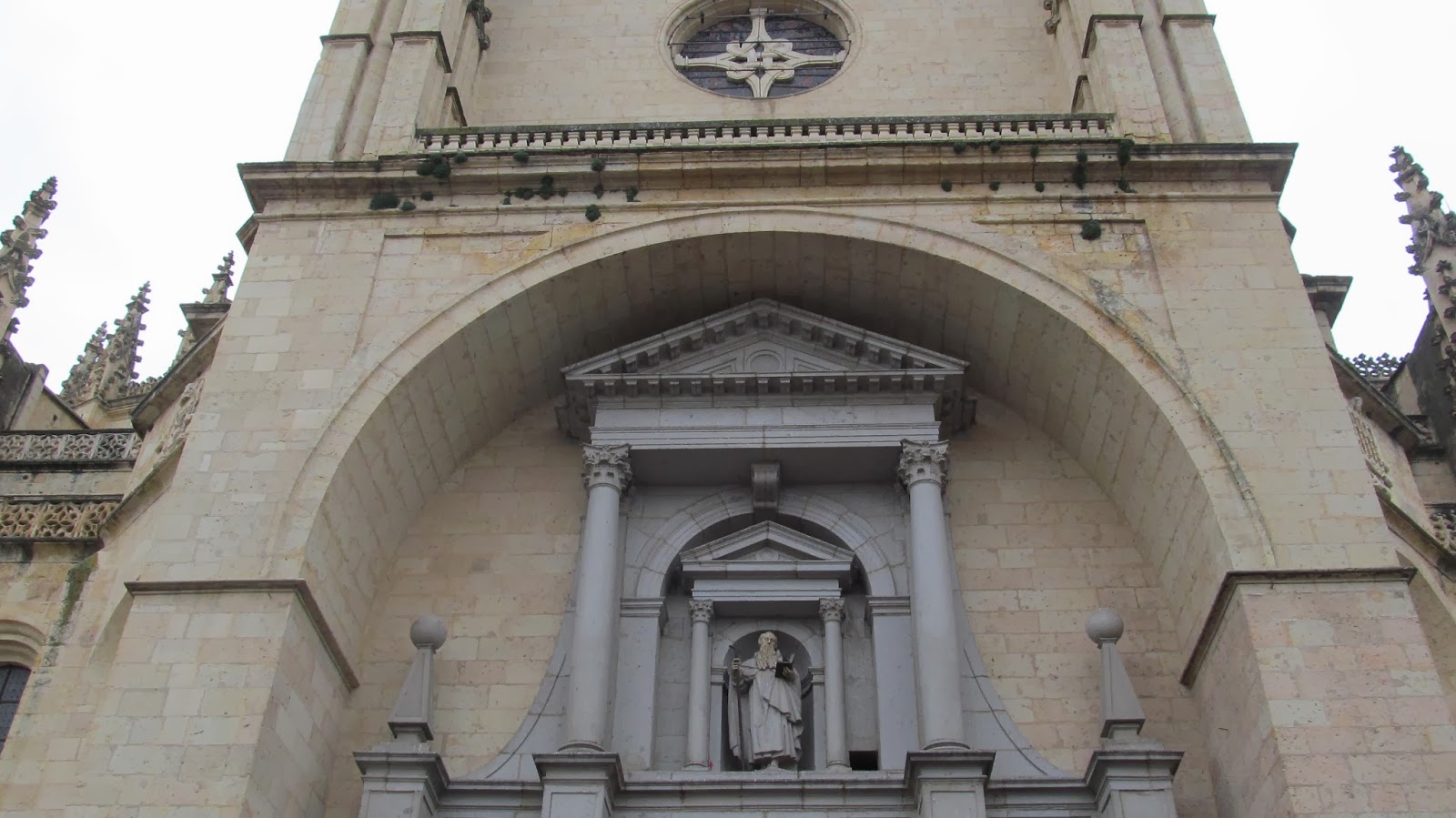Method of Transportation: Walking
Transportation Time: Approximately 4 Minutes
Hours:
Monday - Saturday:
October - March 9:30 a.m. - 5:30 p.m.
April - September 9:30 a.m. - 6:30 p.m.
Sundays: 9:30 a.m. - 1:30 p.m.
Cost:
$4.09/€3
Groups over 20 $2.73/€2
Free on Sunday
The Cathedral of Segovia is one of
the Segovia’s iconic structures. Located in the Plaza Mayor, construction of
the cathedral began in 1525 to replace the old cathedral that had been
destroyed in 1520[1]. Not
consecrated until 1768, the cathedral is the last Gothic age cathedral built in
Spain[2]. Due to its longevity, it has a
combination of both late Gothic and Renaissance styles.
 |
| Architecture |
There are many key features of the
cathedral that can be seen from the outside. At the main entrance from the Plaza
Mayor is located the statue of the Virgin Mary. The entrance is known as “Puerta
del Perdon,” or “Door of Forgiveness[3].”
There is an outer area extending
from the cathedral, along with the tower.
The tower was used as the home of the bell ringer until the mid-20th
century and today requires special permission to access[4].
The cathedral itself stands one hundred and five meters by fifty meters long
and is thirty-three meters high at its tallest point, the center part of the church[5].
With its impressive size and height, the cathedral is one of the most recognizable
structures in the Plaza Mayor. The central point is surrounded by “buttresses
and pinnacles of ornate Gothic limestone,” which reflect its 16th
century origin[6].
 |
| "Puerta del Perdón"or Door of Forgiveness |
Once inside the cathedral,
photographs are not allowed unless in the outside walkway. Artifacts are sensitive
to light, which can cause deterioration of the artifact. Deterioration is
defined as when an “object reaches a state of physical and chemical equilibrium
with its immediate environment,” and occurs inevitably[7].
It is important to preserve these artifacts and allowing photographs can cause
damage over time. The artifacts must have consistently maintained light,
temperature, and relative humidity in order to be properly conserved; inadequate
light levels can cause physical and chemical deterioration to artifacts[8].
Specific to the cathedral are a number of old books, paintings, and
tapestries that are extremely light-sensitive.
 |
| Inside the Late-Gothic Cloister |
Inside, the cathedral is
surrounded by historic artifacts. The inside of the cathedral alone includes
eighteen chapels and an archive that contain various artifacts from various centuries,
reflecting the history of Segovia. Some of these artifacts include 16th century
hymn books and tapestries, “el Cristo Yacente” or the Recumbent Christ statue
by Gregorio Fernández, and two full size baroque pipe organs[9].
The 16th century stain glass windows and altarpiece display the
history of the prominent Catholic culture of Segovia. The archives of the
cathedral also contain and preserve over five hundred early printed books, including
Sinodal de Aguilafuente, which was the
first book printed in Spain[10].
 |
| Inside the Late Gothic-Cloister |
The cathedral is still in use and has a regular service every Sunday. It echos the changes throughout its time
and is one of the most remarkable structures in the Plaza Mayor. Serving as a
historic symbol of the town and its history, the cathedral remains a monument
to the history of Segovia.
Works Cited
“Catedral.” Segovia!. Turismo de Segovia, 2014. http://www.turismodesegovia.com/es/que-ver/monumentos/catedral.
(accessed January 30, 2014).
“Segovia Cathedral.” Spain.info. Sociedad Estatal para la Gestión de la Innovación y las
Tecnologías Turísticas, 2013. http://www.spain.info/en/que-quieres/arte/monumentos/segovia/catedral_de_segovia.html.
(accessed January 30, 2014).
“Museum
Collections Environment.” NPS.gov. NPS
Museum Handbook, 1999. http://www.nps.gov/museum/publications/MHI/CHAPTER4.pdf.
(accessed January 30, 2014).
[1] “Catedral,” Segovia!. Turismo
de Segovia, 2014, http://www.turismodesegovia.com/es/que-ver/monumentos/catedral
(accessed January
30, 2014).
[2] “Segovia Cathedral,” Spain.info. Sociedad Estatal para la
Gestión de la Innovación y las Tecnologías Turísticas, 2013, http://www.spain.info/en/que-quieres/arte/monumentos/segovia/catedral_de_segovia.html
(accessed January 30,
2014).
[3] “Catedral,” Segovia!. Turismo
de Segovia, 2014.
[4] Ibid.
[5] “Segovia Cathedral,” Spain.info. Sociedad Estatal para la
Gestión de la Innovación y las Tecnologías Turísticas, 2013.
[6] “Catedral,” Segovia!. Turismo
de Segovia, 2014.
[7] “Museum
Collections Environment,” NPS.gov. NPS
Museum Handbook, 1999, http://www.nps.gov/museum/publications/MHI/CHAPTER4.pdf
(accessed January 30, 2014).
[8] Ibid.
[9] “Catedral,”
Segovia!. Turismo de Segovia, 2014.
[10] Ibid.




